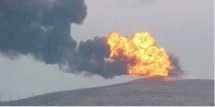
February Editorial
Volcanoes - top air polluters?

February Editorial
Volcanoes - top air polluters?
|
|
The recent eruptions of Mount St. Helens have produced a massive emission of volcanic gases. It has been estimated that the volcano is pumping out approximately 50 to 250 tons of sulphur dioxide every day. Sulphur dioxide is a gas that stings the eyes and throat and which isthe main constituent of acid rain. But Mount St Helens is not an exception. Indeed this volcano produces relatively little acid rain in comparison to other volcanoes world-wide. For example, Mount Etna in southern Italy has beenknown to produce 100 times more sulphur dioxide during eruptions. Indeed , Mount Etna spawns acid rain and a type of bluish smog that volcanologists call vog, which can affect large swaths of Europe. The eruption of Mount Pinatubo in 1991 produced so much gas that the effect was felt across the globe. Every time the Kilauea Volcano on Hawaii's Big Island erupts, it churns out 2,000 tons a day of sulphur dioxide, creating an acid fog that damages local crops. Other noxious gases which are released in smaller amounts during eruptions include hydrogen sulphate and hydrogen chlorite. The how much gas and what type depends on the chemical makeup of the molten rock Then of course is the carbon dioxide. Although CO2 is not considered an air pollutant, is is the major gas contributing to global warming. However, you cannot just put a cap on the top of a volcano and shut it down, so we have to live with it. But do volcanoes make a major contribution to pollution and global warming? To answer this question we have to look at some statistics:
These statistics clearly show that the gas emissions from volcanoes are small, if not trivial, on a global scale. This does not mean that locally they do not inflict serious damage. Clint Bowman, an atmospheric physicist for the Washington Department of Ecology, has remarked that if Mount St Helens was a factory it wouldn't get a permit to operate. However, volcanoes do clean up after themselves to some extent. As wet winter storms come, the rainwater acts as a natural scrubber, washing the sulphur dioxide from the air. So Mother Nature does its bit. Can we say the same about us? |
| _______________________________ | ||||
| Home | | | Shopping | | | Database |
© Biscuit Software 2004-2015
All rights reserved